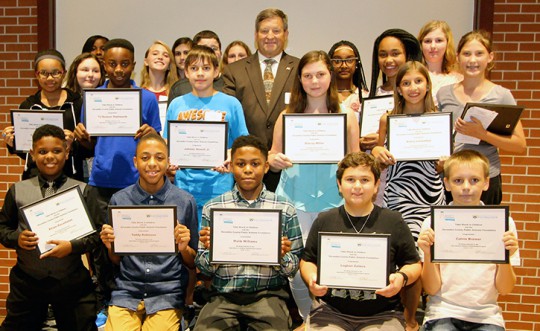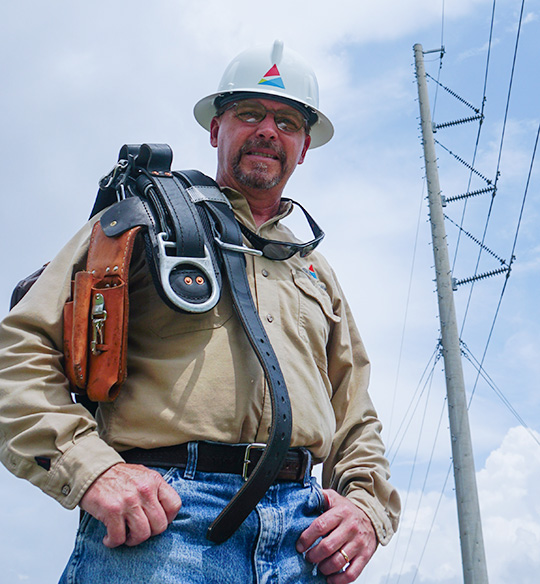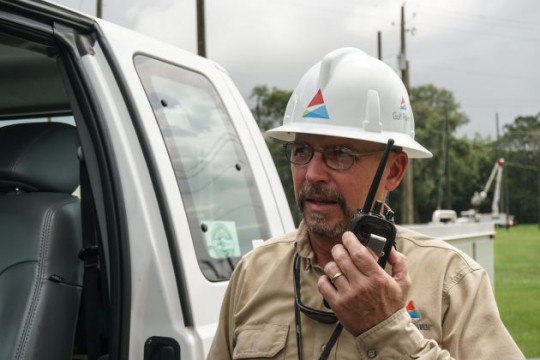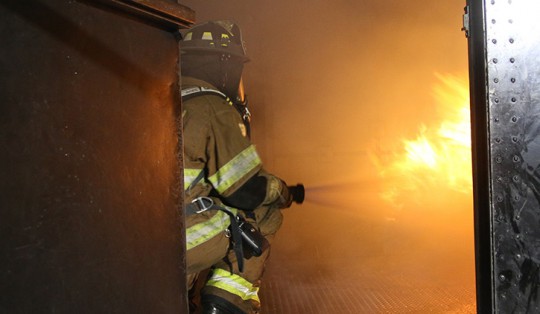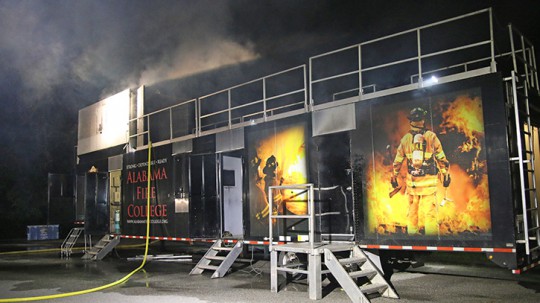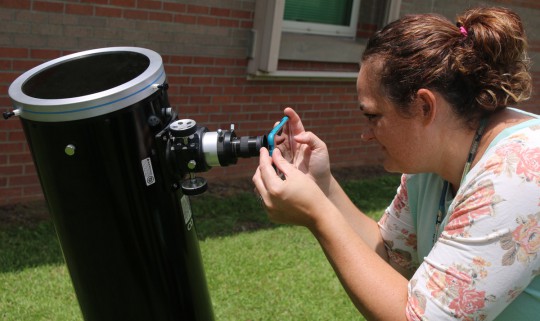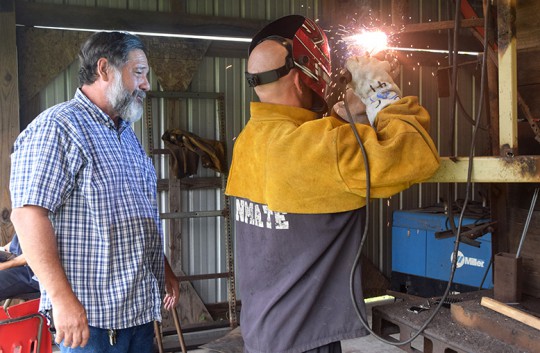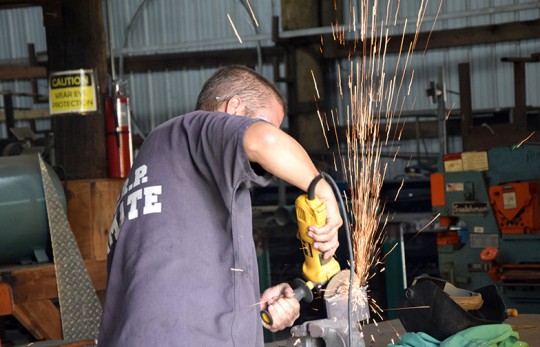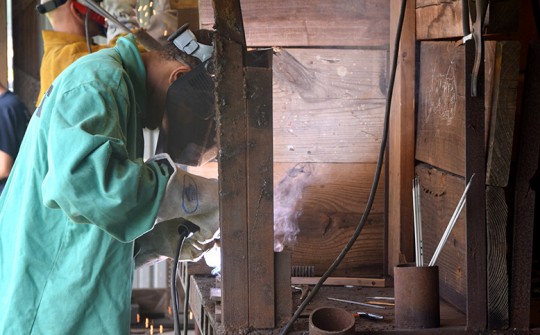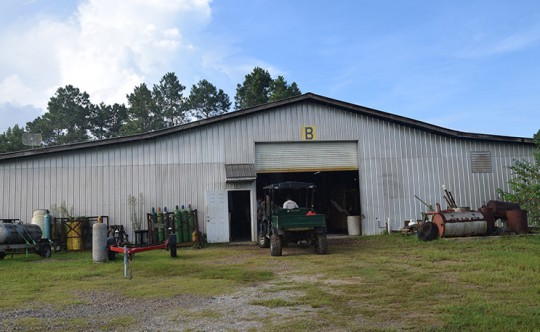Weekend Gardening: It’s Easy To Attract Hummingbirds
September 3, 2017
by UF/IFAS Extension Service
Few sights are more thrilling in the garden than rapidly moving hummingbirds darting among colorful flowers. Hummingbirds, also known as hummers, are always a wonder to see, and it’s easy to attract them to your garden.
In Florida, we see three different types of hummingbirds, but the most common is the ruby-throated. This feathered jewel is only about three inches long and weighs as little as a single penny.
For their size, hummingbirds have among the largest appetites in the bird world. They feed every 10 or 15 minutes from dawn until dusk. During this period, they eat more than half their weight in food and 8 times their weight in water.
If you’re fascinated by hummingbirds, you probably hang out a feeder or two in the summer to provide them with sugar water. Artificial feeders will attract hummingbirds.
 However, feeders should not be the sole source of food provided. The sugar solution may appeal to the hummingbirds’ sweet tooth, but it provides little nourishment. Nectar is much more vital to the hummingbird than just water and sugar. By planting certain flowers and shrubs, home gardeners can provide food and habitat for hummingbirds.
However, feeders should not be the sole source of food provided. The sugar solution may appeal to the hummingbirds’ sweet tooth, but it provides little nourishment. Nectar is much more vital to the hummingbird than just water and sugar. By planting certain flowers and shrubs, home gardeners can provide food and habitat for hummingbirds.
Typical hummingbird flowers are red, have a tubular shape and have no strong scent. But there are several notable exceptions to this general rule. Many plants with red flowers don’t contain very much nectar. Roses, petunias, geraniums and zinnias have brilliant colors but little nectar.
Plants that produce an abundance of flowers over an extended period of time and those that require little care are good choices. Native plants can “fill the bill” where nectar-seekers are concerned and should be used whenever possible.
 Perennials that are recommended as nectar sources include butterfly milkweed (Asclepias tuberosa), red basil (Calamintha coccinea), shrimp plant (Justicia brandegeana), cigar plant (Cuphea ignea), firespike (Odontonema stricta), red star hibiscus (Hibiscus coccineus), and obedient plant (Physostegia spp.).
Perennials that are recommended as nectar sources include butterfly milkweed (Asclepias tuberosa), red basil (Calamintha coccinea), shrimp plant (Justicia brandegeana), cigar plant (Cuphea ignea), firespike (Odontonema stricta), red star hibiscus (Hibiscus coccineus), and obedient plant (Physostegia spp.).
It’s also important to plant a mixture of nectar producing trees, vines and shrubs that have overlapping blooming seasons. This will insure that a continuous source of nectar will be available to hummingbirds throughout the growing season. Some of the species recommended include red buckeye, bottlebrush, firebush (Hamelia patens), wild azalea, trumpet vine, and coral honeysuckle.
Contrary to popular belief, hummingbirds are not strictly nectar feeders. Insects and other invertebrates are the primary source of protein for adult hummingbirds and their young. An adult female can consume up to 2,000 insects per day. Small invertebrates including mosquitoes, gnats, small bees, fruit flies, spiders, caterpillars, aphids, and insects eggs make up the hummingbirds diet. So keep your plants free of pesticides. Pesticides destroy the insect food base vital to hummingbirds and their offspring, and may also contaminate the nectar they drink.
 And if you do use artificial feeders, remember that the sugar solutions must be kept fresh. Florida’s hot weather can cause rapid bacterial growth in these feeders and birds that drink contaminated water could die. To avoid this, change the solution every 3 to 5 days. Clean the feeders with hot water and white vinegar. Do not use soap or chlorine bleach.
And if you do use artificial feeders, remember that the sugar solutions must be kept fresh. Florida’s hot weather can cause rapid bacterial growth in these feeders and birds that drink contaminated water could die. To avoid this, change the solution every 3 to 5 days. Clean the feeders with hot water and white vinegar. Do not use soap or chlorine bleach.
New Students Selected For Take Stock In Children Scholarship Program
September 2, 2017
Take Stock in Children recently introduced 25 new scholarship recipients.
There are now a total of 126 students in grades 7-12 in Escambia County’s program. Students will receive a college scholarship upon graduation from high school, as long as they maintain good grades, attendance and citizenship, remain crime and drug free, and meet weekly with a volunteer community mentor.
The newly selected students include:
- Bailey Middle – Emili Campbell, Avery Leventhal, Kendall Poston
- Bellview Middle – Ty’QuJuan Stallworth, Aiden Wilson
- Brown Barge Middle – Kelsey Bolling, Michael Dorsey, Kiana Hollis, Efrain Escarfullett III
- Ernest Ward Middle – Johnnie Howell Jr., Loghan Zellers
- Ferry Pass Middle – Abbie Brunson, Rafeal Goodwin II, Jayla Rudolph, Trinity Weaver
- Ransom Middle – Calvin Brewer, Alonna Brown, Shelby Lewis, Kiara Mullins
- Warrington Middle – Eunique Crosby, Kylie Williams
- West Florida High – De’mayla Jenkins
- Woodham Middle – Malik Williams, Stacey Miller
Take Stock in Children is a statewide non-profit organization that provides “scholarships, mentors & hope” to deserving young people selected through a need-based application process through the public middle schools at the end of their 6th grade year. Scholarship donations from local foundations, organizations, businesses and individuals are matched dollar-for-dollar when scholarships are purchased from the Florida Prepaid College Foundation each year and are held until students successfully graduate from high school.
Donations Making New Vet Station Possible For Panhandle Equine Rescue
August 29, 2017
Panhandle Equine Rescue is well on their way to a new “Vet Station” at their Cantonment facility, thanks to the generosity of several donors.
Ready Mix USA of Pensacola donated nine yards of concrete that was poured Monday. Lee’s Concrete provided discounted labor. The Escambia County 4-H Horse Club has arranged to have a stock built as a member donation.
The Vet Station will also have a hot/cold wash rack and a scale.
“We are so grateful to our community for their support,” said Pandhandle Equine President Diane Lowery.
The non-profit Panhandle Equine Rescue relies on public donations and volunteers to rescue, rehabilitate and provide adoption services for abused, neglected and abandoned equines in Escambia County.
Pictured: Concrete is poured Monday for a new Vet Station for Panhandle Equine Rescue in Cantonment. Photos for NorthEscambia.com, click to enlarge.
Tate Graduate Morton Graduates From Basic Military Training
August 27, 2017
U.S. Air Force Air National Guard Airman Christopher A. Morton graduated from basic military training at Joint Base San Antonio-Lackland, San Antonio, Texas.
 The airman completed an intensive, eight-week program that included training in military discipline and studies, Air Force core values, physical fitness, and basic warfare principles and skills.
The airman completed an intensive, eight-week program that included training in military discipline and studies, Air Force core values, physical fitness, and basic warfare principles and skills.
Airmen who complete basic training also earn four credits toward an associate in applied science degree through the Community College of the Air Force.
Morton is the son of Stefanie R. and Wade F. Morton II of Pensacola.
He is a 2015 graduate of J.M. Tate High School.
Following In His Father’s Footsteps: Lineworker Appreciation Day
August 26, 2017
People who have endured long power outages in the wake of hurricanes or tornadoes applaud lineworkers. Some even call them heroes.
Curt Cunningham, who has been working on hundreds of miles of distribution and transmission lines for Gulf Power since 1991, flashes a smile and laughs at the thought. But he admits lineworkers do feel a sense of triumph when they make repairs and see the sparkle of lights springing back to life across a neighborhood.
“Sometimes we do feel like a hero, because we are the people our customers see and come out and thank when we get the lights back on,” said Cunningham, a Gulf Power Transmission lineworker. “But there are a whole lot of other people behind that crew who help get the lights on.”
Despite the nod to a large Gulf Power transmission and distribution team supporting lineworkers, Cunningham and his 182 colleagues are the first responders. When the lights go out, they can be called on in the middle of the night and in all sorts of weather to make repairs and restore power. Their mantra is to do the work “as safely and quickly as possible.”
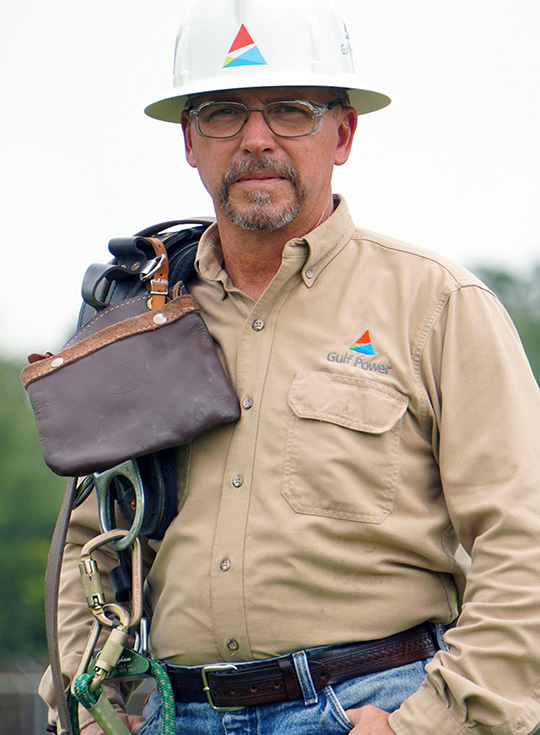 Line work is considered among the top 10 most dangerous jobs in the world. After the Florida House of Representatives designated Aug. 26, 2012 Lineworker Appreciation Day, utilities across the state observe that day annually to honor the thousands of men and women who risk their lives every day to ensure customers receive reliable energy 24/7, 365 days a year.
Line work is considered among the top 10 most dangerous jobs in the world. After the Florida House of Representatives designated Aug. 26, 2012 Lineworker Appreciation Day, utilities across the state observe that day annually to honor the thousands of men and women who risk their lives every day to ensure customers receive reliable energy 24/7, 365 days a year.
Cunningham was attracted to the industry at an early age, despite the inherent dangers. His father, Royce, once worked on a Gulf Power line crew and often talked about the job and the men he worked with.
“My dad was a big influencer, and I always looked up to this trade and the men who worked in it,” said Cunningham. “I was already in the electrical trade, and for me this was the career to shoot for.”
He worked as an electrician and earned a bachelor degree in Criminal Justice from University of West Florida before joining Gulf Power, and working in distribution –– the segment of the power grid that feeds homes and businesses. His first set of climbing tools were his father’s, and he learned the work on the job from the veterans.
“A lot of things have changed in my 26 years,” he pointed out. For instance, safety measures have improved and newly recruited lineworkers have comprehensive training that includes diet and fitness education and a seven-year apprenticeship.
The married father of two grown daughters spent half of his career working on the distribution in Pace, Milton and Gulf Breeze. He did his share of storm duty –– heading out into the aftermath of a hurricane, tropical storm, tornado or ice storm to repair the electric grid and restore power. That duty often requires days and weeks working long hours. Gulf Power lineworkers even travel to neighboring communities and out of state to assist other utility companies with storm restoration.
About 12 years ago, he became a transmission lineworker. He’s one of 10 who work on the high voltage lines and towers that transport power from generation facilities to substations, which feed the distribution lines that serve Gulf Power’s customers.
“Transmission gave me the big picture view of the team that supports lineworkers. By having working relations with system controls, relay and protection, substation workers and engineers, you understand the scope of what goes into just changing out a support arm on a tower,” he said. “It’s a huge team our customers don’t see.”
Cunningham said he joined transmission at one of the most interesting times in Gulf Power’s history.
“I have been involved in one of the biggest investments in the transmission system the company has ever done –– building new tie lines to Alabama, new lines from Pensacola to Panama City and upgrading transmission substations,” he said.
His team is also nearing completion of a huge, multi-year storm hardening project to replace every wooden arm –– 1,500 –– on transmission towers with steel ones. Cunningham said the upgrade and other improvements Gulf Power has invested in the transmission system have reduced outages and improved power reliability. This leads to fewer of those middle-of-the-night calls for lineworkers to rush out and restore power, he said.
On a day-to-day basis, he travels some of the 1,667 miles of transmission lines in his utility truck from the Pensacola area east to Fort Walton Beach inspecting towers, poles and equipment for deterioration or damage.
The opportunity to be out in rural areas where many of the transmissions lines lace across fields, forests, swamps, rivers and bays is what he likes best about transmission work. “I cover a lot of territory and in a lot of remote areas,” he said. “That’s one of the challenges of transmission for some people, but for me, I love it.”
Sometimes to access those remote areas he and his team board boats and an amphibious tractor called a Marsh Master to go to work. That’s what they had to do during the holiday season a few years ago when a transmission tower spanning a river fell.
“I got a call at 2 a.m. that we had a transmission line out,” he said. “We started getting our crews in and picking up our boats and amphibious tractor. That’s the only way we could get out and see what was wrong. As soon as it was light enough before dawn for us to see, we were in the water.”
Whether it’s an emergency job or completing a storm-hardening project, Cunningham said what makes him enjoy his job is “at the end of the day you can look at what you’ve done and say, ‘there’s a job I completed.’
“And we may not always see the lights come back on when we’re working in remote areas, but we get that radio call confirming our work was a success,” Cunningham said. “You feel good.”
Photos for NorthEscambia.com, click to enlarge.
Trial By Fire: Firefighters Undergo Live Fire Training
August 25, 2017
 Firefighters from several area departments are receiving live fire training this week in the Alabama Fire College’s burn trailer at the Flomaton Fire Department. Firefighters have a chance to experience live fire in a controlled environment, practice search and rescue and safely experience a flashover effect.
Firefighters from several area departments are receiving live fire training this week in the Alabama Fire College’s burn trailer at the Flomaton Fire Department. Firefighters have a chance to experience live fire in a controlled environment, practice search and rescue and safely experience a flashover effect.
Participating fire department include Flomaton, Barnett Crossroads, Brewton, McCall and Century.
Pictured: Members of the Flomaton Fire Department undergo live fire training Thursday night. NorthEscambia.com photos, click to enlarge.
Escambia Fire Offering Free Smoke Detector Sign Ups At Elementary Open Houses
August 24, 2017
Escambia County Fire Rescue is partnering with the Escambia County School District to attend open house events for 12 local elementary schools, with a goal of promoting fire safety and the county’s free smoke detector program. ECFR firefighters and staff will be distributing information about the program, and attendees will have the opportunity to sign up to have a free smoke detector installed in their home.
Escambia County Fire Rescue will be attending open house events on Thursday, Aug. 31 at the following Escambia County schools:
- Blue Angels Elementary — K-2nd 5:00- 6:00 PM 3rd-5th 6:15 -7:15 PM
- C.A. Weis Elementary– 5:00 – 6:30 PM
- Ferry Pass Elementary — K-2nd 5:30-6:30 3rd-5th 6:00-6:30
- Jim Allen Elementary — 6:00 – 7:00 PM
- Longleaf Elementary — 6:00 – 7:30 PM
- Montclair Elementary — 5:30 – 6:30 PM
- Myrtle Grove Elementary – 6:00 – 7:30 PM
- Oakcrest Elementary — 5:30 – 6:30 PM
- Pleasant Grove Elementary — K-2nd 5:30 – 6:15 3rd-5th 6:30 – 7:15
- Warrington Elementary — 5:00 – 6:30 PM
- West Pensacola Elementary — 6:00 – 7:00 PM
And on Thursday, September 15:
- Molino Park Elementary — 6:00-7:00 PM (general assembly begins at 5:30)
Smoke detectors that are properly installed and maintained play a vital role in reducing fire deaths and injuries. According to the National Fire Protection Association, a working smoke detector cuts the chances of dying in a reported fire in half.
For more information, contact Escambia County Fire Rescue at 850-475-5530 or fire@myescambia.com. For information about obtaining a home smoke detector, call 850-595-HERO (4376). City of Pensacola residents may call 850-436-5200 for smoke detector installation assistance.
Students View Eclipse (With Photo Gallery)
August 22, 2017
A small group of students at Northview High School were able to watch the solar eclipse on Monday.
 Using approved eclipse glasses, they were able to watch most of the eclipse up until just before the 1:35 p.m. maximum time when clouds rolled over the sun.
Using approved eclipse glasses, they were able to watch most of the eclipse up until just before the 1:35 p.m. maximum time when clouds rolled over the sun.
Teachers and staff were also able to use an 8-inch telescope with proper filter to observe the eclipse.
NorthEscambia.com photos, click to enlarge.
Weekend Gardening: August To Do List
August 19, 2017
Here are gardening tips for the month of August from the UF/IFAS Extension program:
What to Plant
- Bedding Plants: The hottest days of summer limit planting now to heat tolerant vinca, gaillardia, bulbine, and coleus.
- Bulbs:Aztec lily, butterfly lily, walking iris, and spider lily can be planted any time of the year, even late summer.
- Herbs: Herbs that can be planted from plants (not seeds) include bay laurel, ginger,Mexican tarragon, and rosemary.
- Vegetables: This month starts the fall planting season. Many cool season crops can be planted now, including a final crop of warm-season vegetables such as pepper. Tomato can be planted for the fall garden.
- Lawn problems: Damaged areas can be the result of insects, disease, or irrigation problems. Be sure to determine the cause so the proper remedy is used. Use a sharp mower blade and only remove 1/3 of grass blade to reduce stress on the lawn.
- Palms: If older fronds are yellowing, you may have a magnesium or potassium deficiency. Apply an appropriate palm fertilizer.
- Poinsettias: Pinch back poinsettias and mums before the end of the month to allow time for buds to form for winter bloom.
- Ornamental Plants: Rapid growth and leaching rains may result in nutrient deficiencies in some plants. Fertilize those plants that show signs of deficiencies.
- Bedding Plants: Remove spent blooms, cut back, and fertilize flowering annuals and perennials to extend the bloom season into the fall months.
- Adjust irrigation based on rainfall.
- Deadhead flowers to encourage new blooms.
- Monitor the garden for insects and disease.
- Plant trees, shrubs, and perennials and water until established.
Road Prison Welding Program Gives Inmates Skills, Success After Incarceration
August 16, 2017
When Welding Instructor Danny Cain hands certificates to Escambia County Road Prison inmates who have completed the welding program at the prison, it’s not unusual to see tears begin to run down their cheeks.
The certificates inmates earn while incarcerated are much more than just pieces of paper – for many, they represent opportunities to build a better future outside of prison.
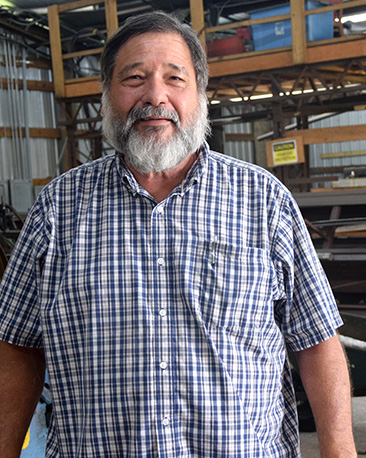 “It gives them a sense of accomplishment, and they know they can do something if they want to,” Cain said. “And that builds character in a person – that builds morals in a person. And a lot of them get out of here and do the right thing, get out and work.”
“It gives them a sense of accomplishment, and they know they can do something if they want to,” Cain said. “And that builds character in a person – that builds morals in a person. And a lot of them get out of here and do the right thing, get out and work.”
Cain began teaching at the Escambia County Road Prison in 2010 with George Stone Technical Center, offering nationally-recognized certifications including stick welding, pipe welding, MIG and TIG welding, or metal inert gas and tungsten inert gas. He typically teaches 12-14 students at a time, all of whom choose to opt into the program during their time at the road prison.
And with a growing number of success stories, Cain said he doesn’t have any problem filling up the class.
“They see people getting out and getting jobs,” Cain said. “They see people getting out and making money, and they say, ‘That’s what I want.’”
During the 2016-17 school year, 30 inmates participated in the welding program through the county’s partnership with George Stone Technical Center. George Stone issued 45 Occupational Certificates of Participation for various welding disciplines, and 21 of the 30 inmates received American Welding Society National Certifications that are recognized through the United States. In the 2015-16 school year, 26 inmates participated in the program, with 23 receiving American Welding Society National Certifications and 66 Occupational Certificates of Participation issued.
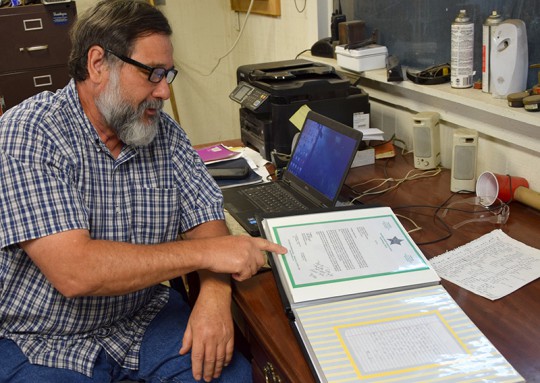 Cain stays in frequent contact with at least 14 of his students from the past two years who are now working in the welding field, and another 10 former students are recently released and seeking employment. Of the 56 inmates who have participated in the welding program since 2015, just five have been rearrested.
Cain stays in frequent contact with at least 14 of his students from the past two years who are now working in the welding field, and another 10 former students are recently released and seeking employment. Of the 56 inmates who have participated in the welding program since 2015, just five have been rearrested.
Former inmates and students in the program are now working everywhere from Oklahoma City to New Orleans, using their new skillset to advance in the welding industry.
Brian Mills, who spent about five months at the road prison in 2013, said he largely credits Cain and the welding program for the opportunities and success he’s found since getting out of prison. With more than 60 felonies on his record, Mills said he did not have much hope for his future career – but receiving his welding certifications changed that.
“When I got out of prison, I didn’t have anything at all, and [Cain] lined me up a job here in Louisiana,” Mills said. “I came over here and started at the bottom, and I just purchased a brand new built house in a brand new subdivision. I’m doing very, very well.”
Having the skills to be able to secure job opportunities after their release is critical for those who have been incarcerated, Mills said. Unlike some other prison educational programs that have long waits and may require months or years to complete, Mills said it’s helpful that some of the welding certifications can be completed by those who aren’t incarcerated for lengthy periods of time.
“For the county to have that program where they’re doing a short amount of time and they’re able to get a bit of welding underneath them, it’s very helpful,” Mills said.
Road Prison Commander Charles Snow said he’s seen firsthand how the welding program can positively impact lives, also stressing the importance of having a solid set of skills to be able to reenter the workforce after incarceration. Snow said that Cain goes above and beyond to help connect his students with good jobs, whether it’s local or out of state.
“They have a job to go into, they have a profession where they can actually prepare a good wage,” Snow said. “So it’s life-changing.”
Cain said it’s the life-changing impact of the program that keeps him going every day. He often receives letters and Facebook messages from former students, and he loves hearing their stories about working, providing for their families and positively contributing to society.
“If they come in here with no skills at all and leave with a trade, I don’t see how you can beat that, really,” Cain said. “And I try to teach them to be more than a welder – I try to teach them to be a man, and step up and do the right thing. I can’t change their past, but I can change their future.”


